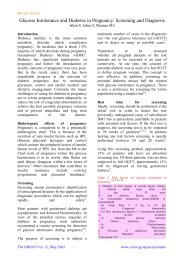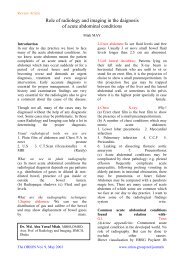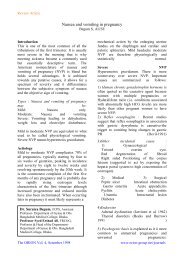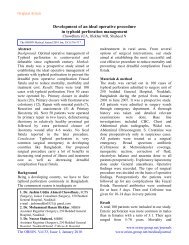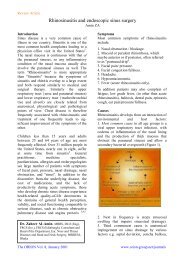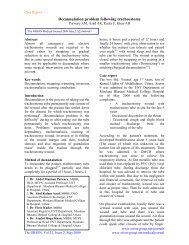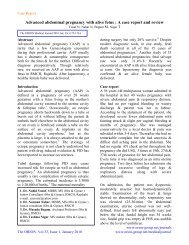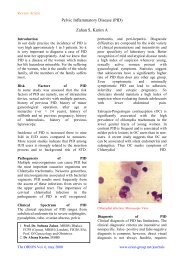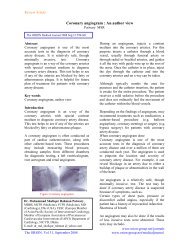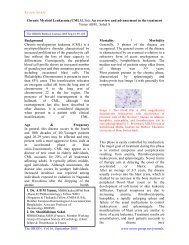Case Reportmaculo-papular, distributed on upper chest,back and upper limb. The rash was mostnoticeable at the height of temperature. Theinvestigations revealed persistent neutrophilicleucocytosis, raised hepatic enzymes withnormal bilirubin. All the microbiological testswere again negative. Chest X-ray, USG ofwhole abdomen was normal. At that moment,left cervical lymphnodes were palpable. Theywere 2 in number, firm , tender, discrete. Alymph node biopsy was done to excludetuberculosis, it showed chronic non specificlymphadenitis. During that period patient wastreated with I/V antibiotics-ceftriaxone,gentamycine, but there was no response. Anechocardiogram was done to excludeinfective endocarditis, revealed only minimalpericardial effusion. About one week afteradmission, patient developed arthralgiafollowed by arthritis involving multiple bigjoints, e.g. shoulder, hip, wrist, elbow. Thispointed to a possible rheumatologicaldiagnosis. Because of the combinations ofhigh fever, arthritis, evanescent rash, sorethroat and lymphadenopathy-<strong>Adult</strong> <strong>onset</strong>Still's <strong>disease</strong> was assumed to be a possiblediagnosis. Serum RA, ANA, both werenegative, CRP was positive and serum ferritinlevel was found to be significantly elevated.So with fulfillment of diagnostic criteria(yamaguchi criteria) and exclusion of othercauses-a final diagnosis of <strong>Adult</strong> Onset Still's<strong>disease</strong> was made.completely. Investigations showed persistentneutrophilic leucocytosis, high ESR, raisedhepatic enzymes & serum ferritin level higherthan before. So decision to start DMARD wastaken. Hydroxy chloroquine was preferredover Methotrexate considering safety profile.4 wks after starting Hydroxy chloroquine 200mg daily along with Aspirin, the patient hadcomplete clinical & biochemical remission.DiscussionThis multisystem inflammatory <strong>disease</strong> hassome common articular and non-articularmanifestations together with typicallaboratory findings. Most common clinicalfeatures of <strong>AOSD</strong> are - arthralgia (98 -100%),fever > 39oc (83-100%), Myalgia (84 - 90 %),rash (87 - 90%), sore throat (50 - 92%). 4Fever is an early feature, quotidian ordiquotidian in pattern with rise of temperaturein early morning/late afternoon. Patient with<strong>AOSD</strong> generally feel very ill while febrile &feel well when body temp is normal. Thisposes a dilemma for the physicians becausehospital rounds usually do not occur duringthe times when the patient is febrile. Alsohere in this <strong>case</strong> the young male lookedabsolutely fine during morning rounds but thetemperature chart showed high spikes atmidnight associated with severe myalgia. Sothe patient received a number of antibioticsfor presumed sepsis.Patient was treated with NSAID. Aspirin waschosen and given in high dose - 2400 mgdaily along with a proton pump inhibitor. 3 4wks after starting the treatment, most of thesystemic features were improved withsubsidence of fever, improvement of appetite& weakness. But the arthritis did not subsideThe ORION. Vol 24, May 2006The rash of Still's <strong>disease</strong> is a salmon-pinkcolour evanescent rash, particularly on upperpart of the body. It is often unappreciatedunless specifically sought and may be seenonly when the patient is febrile. The rashshows Koebner phenomenon anddermatographism. The patient also stated thathe had similar rash for a few days before itwww.orion-group.net/journalswww.orion-group.net/medicaljournal
Case Reportcould be particularly sorted out on carefulexaminations. Arthritis is often late <strong>onset</strong> andover shadowed by systemic features. Thismay be responsible for the <strong>disease</strong> being oftencategorized as PUO. The joints mostcommonly involved in decreasing frequencyare - wrist, knee, ankle and elbows. Erosion &fusion of the carpal bones (50%), tarsel bones(20%), cervical spine (10%) may also beseen. A destructive arthritis is seen in up to20-25% <strong>case</strong>s. Our patient developed arthritismore than 3 wks after the <strong>onset</strong> of fever &was characterized by large joint polyarthritis.Other clinical features include -lymphadenopathy (48-74%) splenomegaly(45-55%), hepatomegaly (29-44%), pleuritis(23-53 %), pericarditis (24-37%). Patientsmay present with complications like acutehepatic failure, aseptic meningitis, DIC etc.The characteristic findings in investigationsare - elevated ESR>50 (90-100%),neutrophilic leucocytosis (71-97%), anaemia(59-92%), hypo albuminaemia (44-85%),thrombocytosis (52-62%), negative RA, ANA(90-100%). Our patient had almost all theabove mentioned biochemical features. Thereis no single diagnostic test for <strong>AOSD</strong>. Anextremely elevated serum ferritin level issuggestive of <strong>AOSD</strong>. 7 Although ferritin levelmay rise in other <strong>disease</strong>s and patient with<strong>AOSD</strong> may also have a normal ferritin level.A value of >1000 ng/dl in proper clinicalsetting being confirmatory of the diagnosis;specially if associated with low glycosylatedferritin level. 6Diagnosis of <strong>AOSD</strong> is one of exclusion, madein the setting of proper clinical features &laboratory abnormalities with the absence ofother explanations such as infection ormalignancy. Several diagnostic criteria havebeen proposed for the diagnosis of <strong>AOSD</strong>.Among them Yamaguchi criteria and Cushcriteria are most popular. 7, 8Yamaguchi criteriaMajor criteria• Fever > 39oC.• Arthralgia /arthritis > 2wks.• Still's rash.•Neutrophilic leucocytosis.The ORION. Vol 24, May 2006Minor criteria• Sore throat•Lymphadenopathy/Splenomegaly.• Hepatic dysfunction• RA/ANA negative.Total > 5 criteria with 2 major criteria. 6Our patient fulfilled all the major & minorcriterias of Yamaguchi criteria-along withfever, arthritis, rash, lymphadenopathy, sorethroat, he had persistent neutrophilicleucocytosis, hepatic dysfunction andseronegativity. Because the <strong>disease</strong> is ainflammatory one, treatment is antiinflammatorydrugs. NSAIDs are themainstay of treatment. Indomethacin/aspirinin high dose are mostly adequate to controlthe articular and systemic features. Howevermore than 60 % patients require systemicsteroid therapy with prednisolone, specially ifsystemic features are not adequatelycontrolled by NSAID. DMARDs-Methotrexate, Hydroxy chloroquine arerequired if there is persistent articularfeatures. TNF-a receptor blockers-etanercept,infiximab are the recent advances in therapybut costly and not available everywhere.9,10Resistant <strong>case</strong>s may be treated with I/Vgamma globulin/Interferon-g, pluscyclophosphamide,cyclosporine,mycophenolate mofetil.Treatment of our patient was started withaspirin in high dose which was adequate tocontrol the systemic features but not thearticular features. So hydroxy chloroquinewas added as <strong>disease</strong> modifying drugs.Prognosis of <strong>AOSD</strong> is variable 2 . The mediantime to achieve remission with therapy is 10months. One third patients have self limited<strong>disease</strong> with remission in 6-9 months. Onethird have intermittent features & one thirdhave chronic progressive <strong>disease</strong>. There aresome poor prognostic features such as -polyarthritis or large joint involvement at the<strong>onset</strong>, hepatic dysfunction & very high serumferritin level >3000ng/dl. Though our patienthad a number of poor prognostic features, hewent into remission within 2 months ofstarting treatment & is still in remission 11/2year after initial diagnosis.References1. Bywaters EGL: Still's <strong>disease</strong> in the adult.Ann Rheum Dis 30: 121-133; 1971.www.orion-group.net/journalswww.orion-group.net/medicaljournal



